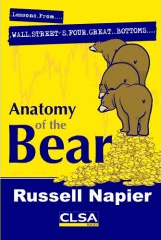 I love to read trading books, so when I was asked to review Russell Napier’s book, Anatomy of the Bear [1], I happily obliged.
I love to read trading books, so when I was asked to review Russell Napier’s book, Anatomy of the Bear [1], I happily obliged.
In the book, Napier examines 4 major bear market bottoms on Wall St., with a portion of the book devoted to each of the major lows created in 1921, 1932, 1949 and 1982. Napier looks at the history of these bear markets, the events leading up to them, and how the investors of those times were impacted throughout the bottoming process. In his research, he examined some 70,000 articles from the Wall Street Journal from the two months before and after the final lows were made, adding some valuable perspectives from the media and traders of the day. These article tidbits give some great insights into life in the trading trenches at the time, which is incredibly helpful in painting the picture of the doom and gloom which ultimately accompanies a lasting market bottom.
Napier also takes the reader back to the situations of each of the major lows, essentially transporting you to the time and the events which led up to the bear phases. He examines wars, monetary policy, politics, economic factors, and anything else which had an impact on the buying and selling motivations of traders, making this book an incredible resource for anyone wanting to learn from lessons of the past.
Here are a few things I found noteworthy:
* Earnings Trailed Price. In the 1921 bottom, price found a low about 4 months before earnings found a bottom. Earnings bottomed some 5 months after price bottomed in the 1932 bottom. That makes for some interesting fundamental vs. technical discussion! (You know which side I’m on)
* Short Interest Stayed High After Lows. Napier discovered that short interest remained rather high even after price made a low, serving as a good reminder that even bears get greedy. In turn, as the shorts end up having to buy to exit their positions, it propels prices even higher, perpetuating the newfound momentum. Napier notes that a large short interest combined with a market that didn’t decline on bad news was an excellent signal in the 1921, 1932 and 1949 lows.
* Bear Markets Don’t Scare You Out. The results of Napier’s research flies somewhat in the face of theories which indicate that capitulation marks a lasting low, revealing instead that bear markets typically end with a final decline on no volume. Essentially, bear markets wear you out, not scare you out.
* Commodities Count. The end of commodity price declines also marked all 4 major equity lows, with copper playing a prominent role as it preceded or coincided with every equity rebound.
The book also ends with a great number of strategic and tactical conclusions drawn from the study of these 4 great bear markets – plenty of reason alone to check out this book.
Thanks to Russell Napier for the chance to review this fine study of the past, I enjoyed the read and learned a great deal from the bear markets of the past.
Jeff White
President, The Stock Bandit, Inc.
www.TheStockBandit.com [2]
[tags]Stock Market Books, Bear Market, Stock Market Lows, Russell Napier[/tags]